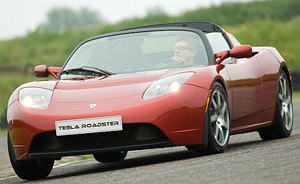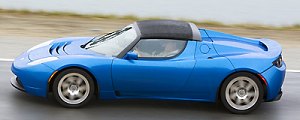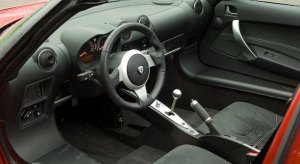|
Tesla Roadster
Debut: 2007
Maker: Tesla
Predecessor: no |
|

|
American wants to revolutionize the
automotive world with this electric car...
|
Two
silicon valley IT engineers founded Tesla Motors in 2003. As outsiders,
they dreamed of revolutionize the automotive world by introducing an
electric sports car. They believe there will be sufficient demand from
Californian environmentalists, Hollywood stars and silicon valley IT
executives to sustain multi-thousand units sales per year. Their idea
attracted billionaires like Elon Musk (founder of PayPal), Lorry Page
and Sergey Brin (both are founders of Google) to invest some US$60
million into Tesla. Five years later, the first production Tesla
Roadster finally reached the hands of customer.
Like many other American dreams, the management of Tesla found the road
to success more bumpy than originally thought. This is because they
lack experience in automotive field. They know their weaknesses as
well, so in the beginning they decided to outsource production and
engineering as far as possible. As you might have predicted from its
looks, its chassis was designed by Lotus based on Elise. Many
components are shared with Elise as well, such as the spaceframes made
of extruded aluminum, the
aluminum double-wishbones suspensions (though with bespoke springs and
dampers), the windshield and interior parts. However, the body panels
are made of carbon-fiber instead of glass-fiber to save weight.
Production of the car takes place at Lotus’s factory in Hethel,
England, alongside Elise.

|
The road to success is more bumpy than
originally thought...
|
The chassis
has its
wheelbase stretched for 52mm to accommodate a big lithium-ion battery
pack in front of the electric motor. Unlike big car makers, Tesla could
not ask giant battery makers like Sanyo, Matsushita or LG to develop a
battery pack specially for its automotive application. Therefore its
battery pack is made of 6831 pieces of laptop computer-grade
lithium-ion battery cells, plus temperature sensors and cooling system.
The IT guys claimed that it offers excellent performance, e.g. 220
miles range and 3.5 hours charging time, but it is bulky and heavy at
450 kilograms. This lifts the kerb weight to 1220 kg and worsens the
weight distribution to 35:65 front-to-rear.
The 3-phase AC inductor motor is made in Taiwan. It produces 248
horsepower and 205 lb-ft of torque. The torque curve, however, is very
different from conventional engines, as it develops peak torque from 0
to 6200 rpm, then decline linearly. Such strong torque means Tesla only
needs a 2-speed manual gearbox to achieve 0-60 mph in 3.9 seconds and a
top speed of 125 mph… at least according to plan.

|
Elise-based chassis offers excellent
ride and handling...
|
Unfortunately,
Tesla’s inexperience was revealed in the engineering of gearbox. They
selected a gearbox design that was not strong enough, nor could they
manage the violent gearshifts through control software. This caused a
year of delay to production. Embarrassingly, Tesla decided to equip the
early production cars with the first gear removed, so using the second
gear only 0-60 mph was increased to 5.7 seconds. Later on, it announced
it will use a new single-speed gearbox to solve the durability and
shifting problems, while a torquer motor will compensate and restore
the original 0-60 mph claims. However, at the time of writing this
so-called Powertrain 1.5 is still on testing stage.
On the Road
In stationary, the Tesla Roadster looks every bit like a slightly
longer and more civilized version of Lotus Elise. It attempts to be
more “luxurious” than the Lotus, but like the last effort by Opel
Speedster, its cockpit is still more like race car than grand tourer.
To enter the cockpit, you have to step across a wide sill and drop into
a thin bucket seat. The tub is narrow. The seat is mounted right on the
floor. The plastics are nasty. The insulation of the cockpit is poor.
Though there are ABS, traction control, cruise control, power windows,
air-con and i-Pod connectivity as standard, the whole cabin looks and
works like Lotus Elise. Well, the 3-spoke steering wheel is donated by
Opel Speedster.

|
Like Opel Speedser, its cockpit is
still more like race car than grand tourer...
|
The similarity
ends
once you start the motor and engage the forward gear. A violent
acceleration force pushes your back right from the gear engagement,
which is quite a discomfort. The force keeps pushing constantly while
the motor spinning smoothly like a washing machine. The mismatch
between acceleration and noise is odd. The lack of gearshift amplifies
this strange experience. Yes, the Tesla is very fast to get off from
traffic lights and up to about 100 mph, but is it as engaging to drive
as conventional sports cars ? Is it as thrilling at high speed ? The
answers are negative.
Fortunately, it rides and handles as well as conventional sports cars.
It runs very much like a heavier and slightly more civilized Lotus
Elise. Thanks to the longer wheelbase and softer suspension setting, it
rides with suppleness unmatched by many sports cars. Its unassisted
steering provides good communication and precision. Its handling is a
little more rear-biased than Elise due to the weight of battery, but it
still provides excellent grip, poise and agility. Larger brakes handle
the extra weight effectively.
Unconventional cars ask for unconventional prices. Tesla Roadster is no
exception. While a top supercharged Elise costs $55,000 in the US, the
Tesla sets you back at $100,000. In the UK, their price gap is even
wider - £36,000 vs £80,000. Only people with strong
environmental conscious mind and deep wallets simultaneously may
consider purchasing it. |
| The
above report was last updated on 14 Jul
2008. All Rights Reserved. |
|
|